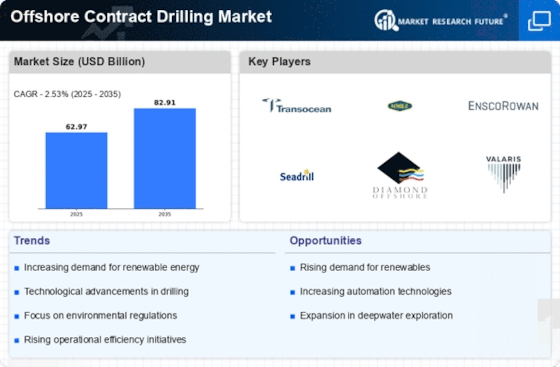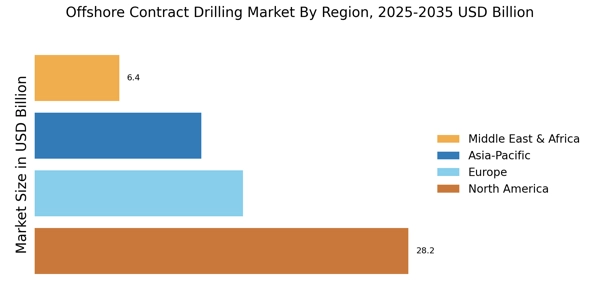Geopolitical Factors
Geopolitical dynamics significantly influence the Offshore Contract Drilling Market. Political stability in oil-rich regions often correlates with increased drilling activities, as companies seek to capitalize on accessible resources. Conversely, geopolitical tensions can disrupt supply chains and deter investment. For instance, recent tensions in the Middle East have led to fluctuations in oil prices, impacting drilling contracts. The Offshore Contract Drilling Market must navigate these complexities, as operators assess risks associated with geopolitical uncertainties. Additionally, countries may implement policies to attract foreign investment in offshore drilling, further shaping market conditions. Understanding these geopolitical factors is crucial for stakeholders aiming to make informed decisions in the Offshore Contract Drilling Market.
Rising Energy Demand
The Offshore Contract Drilling Market is experiencing a surge in demand for energy, driven by increasing global consumption. As economies expand, the need for oil and gas escalates, prompting exploration and production activities in offshore regions. According to recent data, energy demand is projected to grow by approximately 1.5% annually, necessitating enhanced drilling capabilities. This trend compels companies to invest in offshore drilling operations, thereby stimulating market growth. The Offshore Contract Drilling Market is likely to benefit from this rising demand, as operators seek to secure contracts for drilling services to meet the energy needs of various sectors, including transportation and manufacturing. Furthermore, the shift towards cleaner energy sources may also influence drilling strategies, as companies adapt to evolving market dynamics.
Environmental Regulations
The Offshore Contract Drilling Market is increasingly influenced by stringent environmental regulations aimed at minimizing ecological impact. Governments are implementing policies that require operators to adopt sustainable practices, such as reducing emissions and managing waste effectively. Compliance with these regulations often necessitates investment in advanced technologies and processes, which can elevate operational costs. However, companies that proactively embrace these regulations may gain a competitive edge, as consumers and investors prioritize sustainability. The Offshore Contract Drilling Market is likely to see a shift towards greener practices, with operators seeking to align their strategies with environmental standards. This trend may also drive innovation, as firms develop new solutions to meet regulatory requirements while maintaining profitability.
Technological Innovations
Technological advancements play a pivotal role in shaping the Offshore Contract Drilling Market. Innovations such as automated drilling systems, advanced seismic imaging, and real-time data analytics enhance operational efficiency and safety. These technologies not only reduce drilling costs but also minimize environmental impact, aligning with regulatory expectations. The integration of digital solutions is expected to increase productivity by up to 20%, making offshore drilling more attractive to investors. As companies adopt these cutting-edge technologies, the Offshore Contract Drilling Market is poised for transformation, enabling operators to explore deeper and more challenging environments. This technological evolution may also lead to the development of new drilling techniques, further expanding the market's potential.
Investment in Renewable Energy
The Offshore Contract Drilling Market is witnessing a notable shift as investments in renewable energy sources gain momentum. While traditional oil and gas exploration remains vital, there is a growing emphasis on integrating renewable energy projects, such as offshore wind farms. This diversification may create new opportunities for drilling contractors, as they adapt to the evolving energy landscape. The Offshore Contract Drilling Market could benefit from partnerships between traditional energy companies and renewable energy firms, fostering innovation and resource sharing. As the world transitions towards cleaner energy solutions, the Offshore Contract Drilling Market may experience a transformation, with operators exploring synergies between conventional drilling and renewable energy initiatives.


















Leave a Comment